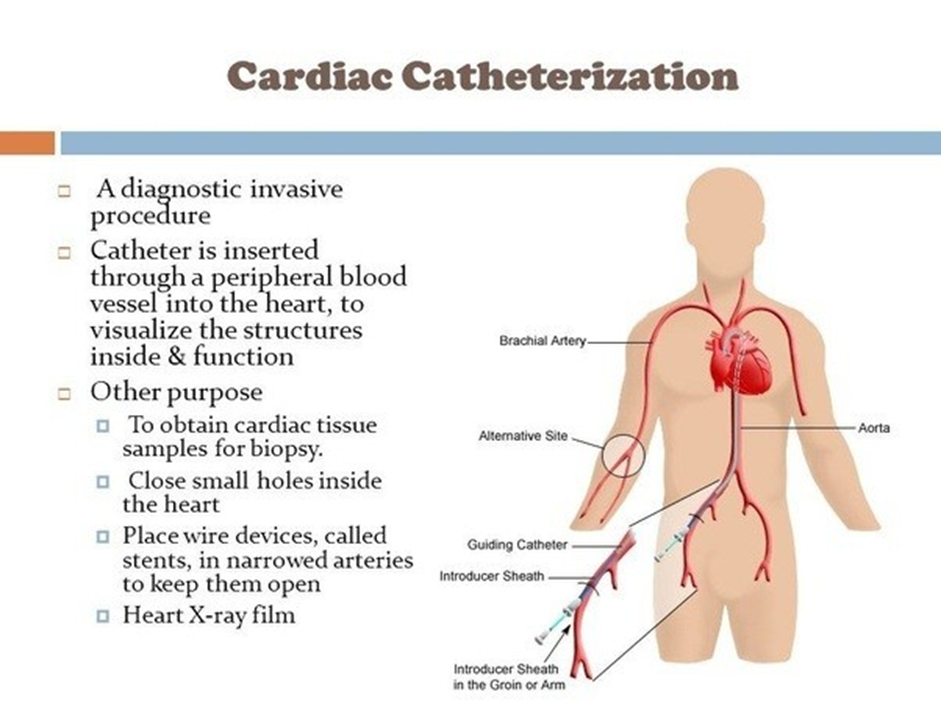A client is scheduled for a cardiac catheterization. The nurse should do which of the following pre-procedure tasks? (SELECT ALL THAT APPLY)
withhold food and oral fluids before the procedure
review medications the client has taken in the last 24 hours
verify that written consent has been obtained
check for iodine sensitivity
administer all ordered oral medications
Correct Answer : A,B,C,D
Withhold food and oral fluids before the procedure
Withholding food and oral fluids before the procedure is essential to prevent complications during the cardiac catheterization. The client is typically NPO (nothing by mouth) for a specified period before the procedure.
B. Review medications the client has taken in the last 24 hours
Reviewing the client's medications is crucial to ensure that any medications affecting coagulation or blood vessels are appropriately managed before the cardiac catheterization.
C. Verify that written consent has been obtained
Verifying the presence of written consent is a critical step to confirm that the client has been adequately informed about the procedure, its risks, and benefits, and has given consent for the cardiac catheterization.
D. Check for iodine sensitivity
Checking for iodine sensitivity is important because iodinated contrast dye is commonly used during cardiac catheterization. Allergies or sensitivities to iodine contrast must be identified to prevent adverse reactions.
E. Administer all ordered oral medications
Administration of oral medications before the procedure depends on the specific medications and the healthcare provider's instructions. Some medications may be held, while others may be continued as prescribed.

Nursing Test Bank
Naxlex Comprehensive Predictor Exams
Related Questions
Correct Answer is B
Explanation
A. “I will have canned chicken noodle soup with crackers and an apple for lunch.”
This option may not be the best choice for a low-sodium diet. Canned soups often contain high levels of sodium.
B. “I will have a tossed salad with cheese and croutons for lunch.”
This option is a better choice, as salads with fresh vegetables can be lower in sodium compared to other options.
C. “I will have a ham and cheese sandwich for lunch.”
Ham and cheese are generally high in sodium, so this would not be a suitable choice for a low-sodium diet.
D. “I will have a baked potato with broiled chicken for dinner.”
This option seems to be a good choice. Baked potato and broiled chicken can be part of a low-sodium meal.
Correct Answer is B
Explanation
A. The development of chronic obstructive pulmonary disease (COPD)
Explanation: The signs and symptoms described, including crackles, orthopnea, S3 heart sound, cough with pink, frothy sputum, and low pulse oximetry, are more indicative of heart failure than COPD.
B. The development of left-sided heart failure
Explanation: This is the correct answer. The signs and symptoms, such as crackles, orthopnea, and cough with pink, frothy sputum, are characteristic of left-sided heart failure. The S3 heart sound is often associated with increased ventricular filling pressures.
C. The development of right-sided heart failure
Explanation: The presented signs and symptoms are more consistent with left-sided heart failure. Right-sided heart failure is often associated with peripheral edema, hepatomegaly, and jugular venous distension.
D. The development of cor pulmonale
Explanation: Cor pulmonale is typically associated with right-sided heart failure due to chronic lung disease. The signs and symptoms described are more indicative of left-sided heart failure.
Whether you are a student looking to ace your exams or a practicing nurse seeking to enhance your expertise , our nursing education contents will empower you with the confidence and competence to make a difference in the lives of patients and become a respected leader in the healthcare field.
Visit Naxlex, invest in your future and unlock endless possibilities with our unparalleled nursing education contents today
Report Wrong Answer on the Current Question
Do you disagree with the answer? If yes, what is your expected answer? Explain.
Kindly be descriptive with the issue you are facing.
